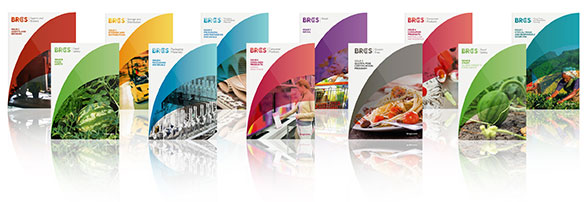Volume 22 | Issue 3

Click here to read the complete illustrated article as originally published or continue below to read the text article.
Today, perhaps more than ever, consumers want transparency in the supply chains delivering the products they buy. Particularly in the world of fast-moving consumer goods and services, consumers want to know where their products are coming from, and how they are made. Founded in 1996 by a group of retailers who wanted to harmonise food safety standards across the supply chain, BRCGS builds trust through the supply chain to give customers this assurance in the products they buy.
Recognising that they often sourced and purchased products from the same factories, and that this added a significant rise in audit burden and cost to the supply chain, the retail group agreed to write a set of common requirements that manufacturing sites could be audited against by an accredited, independent third party. If successful, the sites would be certificated and these certificates available on a public directory for viewing by existing and prospective stakeholders. This provides harmonisation of quality and integrity as well as value-for-money, in that duplicated audits were no longer required by different bodies, freeing up valuable internal technical resources and budget.
BRCGS’ programme of global schemes–now covering food and non-food sectors, as well as, since August 2019, Standards for ethical trade and responsible sourcing – is therefore designed to protect brands and consumers through risk-based process and system evaluation.
Different to manufacturers’ own audits, or even those conducted by a second party but to the manufacturer’s own design, BRCGS’ Standards are independent, accredited third-party audit schemes delivered through certification bodies. In addition, BRCGS’ whole suite of Standards is continuously monitored and updated and re-issued approximately every 3 years.
These schemes, or ‘Standards’, are now used by over 28,000 certificated suppliers over 130 countries, with certification issued through a global network of accredited certification bodies.
So why is this BRCGS certification so important?
Running through the core of every Standard is the requirement to specify the product safety, quality and operational criteria that must be in place within a manufacturing organisation in order to fulfil its obligations with regards to legal compliance and protection of the consumer.
Requirements for BRCGS Standards provide a more demanding audit threshold and often exceed customers’ quality requirements.
Delivered by a global network of highly- trained auditors and experienced certification bodies, each year nearly 300,000 audit hours are spent on the factory floor to perform technical audits for certification of head office and manufacturing sites. Three basic ingredients must be in place: a highly committed senior management team; a hazard analysis and risk assessment-based product safety programme and a supporting quality management system.
The audit standards and certification process is stringently maintained and consistent worldwide through a rigorous compliance program. In essence, BRCGS checks the work and conduct of the network of approved, registered auditors, and is itself scrutinised by accreditation bodies and GFSI (Global Food Safety Initiative). This ensures BRCGS’ Standards are the gold standard in third-party auditing.
Let’s take a closer look at what benefits being certificated to these Standards can bring industry partners.
The Global Standard for Food Safety – the first and largest global GFSI manufacturing scheme of its kind – has been developed by food industry experts from retailers, manufacturers and food service organisations to ensure it is rigorous and detailed, yet easy to understand.
First published in 1998, the Food Safety Standard is now in its eighth issue and provides a framework to manage product safety, integrity, legality and quality, by defining the necessary operational controls for manufacturing, processing and packing of food and food ingredients.
This Standard is the only one of its kind to offer a food safety and quality culture assessment, something that is becoming increasingly important in today’s sector. Similarly, the Standard expands the requirements for environmental monitoring and encourages sites to continue developing systems for security and food defence.
Not only simply recognised and accepted by many retailers, manufacturers, ingredients companies, food service organisations and raw material processors worldwide, as part of their supplier approval process, certification to BRCGS’ Standards is now often specified as a fundamental requirement, as it helps to mitigate risk, reduce waste, complaints, recalls and rejected products.
Originally introduced in 2006, the Global Standard for Storage and Distribution provides the essential certification link between the range of BRCGS manufacturing Standards and the end user, such as the retailer or the food service company.
Developed by multi-stakeholder groups including industry representatives from certification bodies, food service organisations and retailers, it is designed to reflect best practice and facilitate a process of continuous improvement through a well-designed risk-based product safety management system.
The objective of the Standard is to ensure that product integrity during storage and distribution is maintained, and that customer confidence is upheld through audit and certification.
Now in its fifth year the Global Standard for Agents and Brokers provides a framework for managing the safety, quality and legality of products for non-manufacturing businesses in the food, packaging and consumer product industries. Agents and Brokers buy, sell or facilitate the trade of products and so this Standard adds enhanced clarity to supply chains.
Introduced in 2016, the BRCGS Standard for Retail provides essential certification for organisations that retail food and non-food products, The Standard covers the activity of retailing, as well as commissary, sourcing and in-store production.
Retailers are obviously the last step in the supply chain prior to the consumer and therefore play a critical role in managing the supply chain, as well as the delivery of goods and services to the consumer.
Updated in 2016, Issue four of the Global Standard for Consumer Products is designed for global specifiers, retailers and manufacturers of non-food raw materials and finished products. Since this is a very large and broad sector, the Standard consists of two parts, covering General Merchandise, and Personal Care and Household. In addition, sites can be certificated at either Foundation Level or Higher level. The resulting flexibility enables sites to choose the right category, as well as providing a clear pathway for continuous development.
The most-recently updated scheme is the Global Standard for Packaging Materials, issue 6, revised and released in August 2019.
The Global Standard for Packaging Materials was the first packaging standard in the world to be recognised by the GFSI benchmarking com mittee and, to date, 4,500 suppliers in over 80 countries have chosen to be certificated to this scheme. The Global Standard for Packaging Materials can be used by any manufacturer producing packaging materials for all types of products – from food to consumer products – at all levels: primary, secondary and tertiary.
The improved and updated Standard still provides a robust framework for all types of packaging manufacturers to assist them in the production of safe, authentic packaging materials and to better manage product quality to meet customers’ requirements, while maintaining legal compliance.
The requirements of Issue 6 evolved from previous issues with an emphasis on senior management commitment, a hazard analysis and risk assessment-based product safety and quality programme and a supporting quality management system. BRCGS’ objective in updating this Standard was to direct the focus of the audits carried out towards the implementation of good manufacturing practices, within a product safety and quality culture of continual improvement, while recognising the diversity and breadth of the packaging industry, and the skills required to audit it. So, the requirements within the Standard now recognise the importance of positive attitudes, values and beliefs towards product safety and quality within the manufacturing environment.
As a result, many retailers, brand owners, raw material processors and packaging manufacturers around the world now support the use of the Standard and accept it as part of their supplier approval processes.
So, as industry continues to adapt to changing customer demands, BRCGS’ mission will remain: improve brand confidence through rigorous supply chain assurance services. With over 28000 certificated sites in over 130 countries, BRCGS continues to be the Global Standard underpinning Brand Reputation through Compliance.
Under our vision of Science For A Safer World BRCGS will continue to work with brand owners, audit and training delivery partners and suppliers globally to build trust and ensure product quality and safety is of a high standard, overseen by extensive compliance processes. www.brcgs.com

Grace Abamba
ABOUT THE AUTHOR
Grace Abamba – Consumer Products & Packaging Global Program Manager, BRCGS
MSc Biotechnology and Applied Molecular Biology, University College London With many years’ experience in Quality Assurance and technical and regulatory compliance for multinational companies, Grace manages the Global Standard for Consumer Products the safety, quality and operational criteria for the manufacture of legally compliant personal care, household and general merchandise products. She chairs the Technical Advisory Committee consisting of retailers, manufacturers, trade associations, certification and accreditation bodies.
Grace was President of the Society of Cosmetic Scientists UK & Ireland 2018 – 2019 and is a Member of the International Consumer Product Health & Safety Organisation (ICPHSO) as well as the Royal Society of Chemistry (MRSC).
In this episode, I sat down with Beejan Giga, Director | Partner and Caleb Emerson, Senior Results Manager at Carpedia International. We discussed the insights behind their recent Industry Today article, “Thinking Three Moves Ahead” and together we explored how manufacturers can plan more strategically, align with their suppliers, and build the operational discipline needed to support intentional, sustainable growth. It was a conversation packed with practical perspectives on navigating a fast-changing industry landscape.